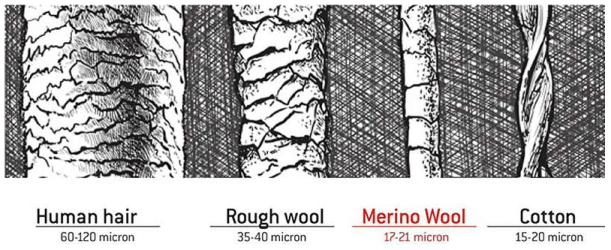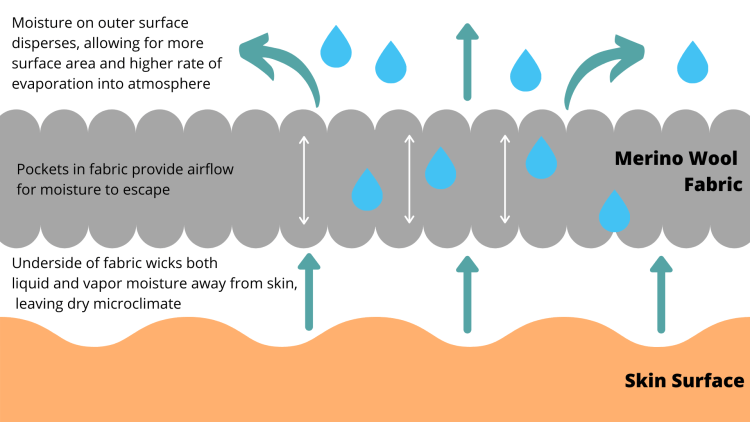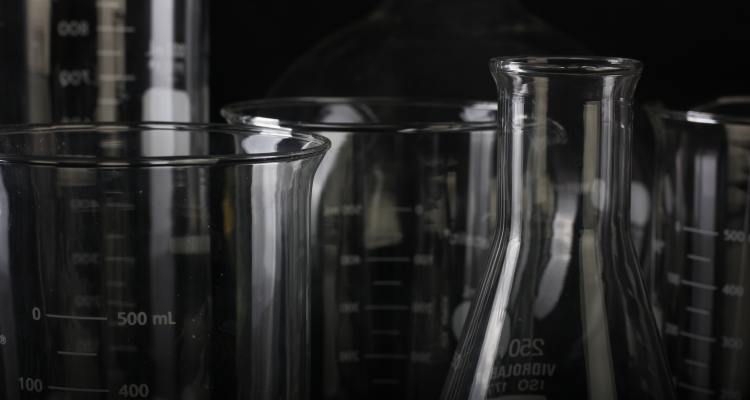Merino Wool is a unique, versatile material that has temperature-resistant properties. Not only does it keep you warm in the winter, but it can help you wick sweat and keep you dry in the summer. The fabric is even an eco-friendly adventurer’s wet dream: it’s sustainable, renewable, and even biodegradable. Basically, the Merino wool benefits are fantastic.
While Merino wool checks off all the boxes of being well, unique, it’s essential to understand the science behind it to appreciate its authenticity altogether. Let’s dive into the sheep pasture to discover the science behind the Merino wool benefits and why it’s such a popular clothing fabric.
Merino Wool Structure
Before we get into the specific science behind Merino’s magic, it’s vital to cut back the layers of a single Merino wool fiber to better understand.
According to Icebreaker’s site (which also has a fantastic guide to Merino wool), the fibers are interlocking proteins, similar to that of human hair. But, when you start to peel back the layers, you begin to see the power Merino wool holds.

A. Exterior Cuticle Cell: The durable exterior protects the interior from damage. The durable shell protects the interior from damage. These cells are water repellent but also absorb vapor from the atmosphere due to a special wax coating.
B. The Cortex: A system of relatively weak bonds that begins to fray with long-term use. Also, it is not very chemical resistant; thus, Merino garments should be cared for with mild laundry detergent.
C. Cortical Cells: A complex inner cell structure playing a significant role in the flexibility, elasticity, resilience, and wrinkle recovery properties.
D. Orthocortical and Paracortical Cells: Responsible for Merino wool crimp due to varying expansions during moisture absorption. The more arranged these cells are, the more crimp available. Hence, more delicate fibers produce more crimp.
E. Macrofibrils: Long fibers that house bundles of fine fibers, surrounded by a matrix section.
F. The Matrix: Consisting of proteins that absorb water molecules which can swell to one-third their size without “feeling” wet. Aids to wick away sweat, absorb terrible smells, provide fire retardancy, and give Merino anti-static abilities.
G. Microfibrils: These are the re-bar support in cement that offers strength, resilience, and flexibility.
H. The Helical Coil: Within the microfibrils, there is a spiral, spring-like structure of protein that helps to prevent the fibers from stretching too much. These structures provide merino wool with its wrinkle-free, elastic, and durable properties.
These challenging scientific terms should not scare you – as they almost did for me. They should merely exemplify the unique physical properties that Merino wool has to offer.
Comfort

Merino Wool Thickness Comparison – Image Credit: chillangel.com
Traditional wool fabrics are often itchy due to their coarse fibers rubbing against the skin. The irritation is mainly because several wool companies tend to use cheaper wool to lower their costs, but that’s not the only reason you’re screeching for days. Traditional wool fibers are about 40 microns thick. They sometimes have a shorter fiber length, which causes the garment to fray and feel rough on the skin.
However, Merino wool is a bit different. The thickness of a Merino fiber is around the range of 20 microns, making them more flexible when weaved into apparel. Also, the fibers tend to be longer and softer, which means it’s more difficult for a loose thread to pop out and annoy you.
The combination of fiber length, fiber diameter, and quality of material improves overall comfort. As we like to call it, Merino wool is the “Cashmere of the People.”
If you want to dive deeper into the science of Merino wool comfort, check our Merino FAQ: Is Merino Wool Itchy?
Temperature Regulation
You may think of wool as a cold-weather material, throwing on a sweater and drinking a cup of tea by the fire. Yet, Merino wool is much more than that. It has specific properties that allow for temperature regulation in warm summer months and chilly winter evenings.
Merino wool acts as a protective layer against the cold in the wintertime, shielding you from the icy elements. Crimps in the thread form tiny air pockets, which, if you’ve ever been in a heat transfer class, air pockets act as an excellent insulator. The fabric’s flexibility absorbs air from the atmosphere and water vapor (generated by heat) from your skin. Merino wool can swell up to 30% of its dry weight before actually appearing wet to the touch. The evaporating effect of sweat is not done on your skin’s surface but instead on the garment. So, there is less of a cooling effect in the winter.
But that’s not all! Merino wool (and wool in general) is a unique fabric. It generates heat as it absorbs water vapor, which is called heat of sorption. The process was discovered in 1858 by a French Scientist who noticed that dry wool, once placed in a humid room, became slightly warmer. It sounds crazy, but it’s one of the reasons Merino is one of the best winter insulators, even if it’s soaking wet!
But what about in the summer? Well, those same crimped fibers that create air pockets to keep you warm also act to keep you cool. When the Merino wool absorbs the person’s heat, the air pockets trap cooler air, thus protecting you from the elements. You’ll feel dry and comfortable even as you hike through the summer sun.
Moisture Management

Any outdoor enthusiast will understand that temperature regulation and moisture control go hand-in-hand. Typically, the dryer you are, the better, which is why Merino wool is a perfect moisture-wicking, breathable fabric.
First, it’s essential to understand what breathability means. In most situations, gases flow from higher to lower concentrations due to their random motion. They disperse. But when barriers are involved, like garments, gases like water vapor can become trapped in the fabric and begin to feel wet. Breathable fabrics assist the natural behavior of water vapor, aiding its transport away from your microclimate.
Merino wool, on the other hand, as mentioned before, can hold nearly one-third of its dry weight in water vapor before feeling wet to the touch. It facilitates water vapor movement generated by the body out into the atmosphere, thus cooling you down.
Other summer clothes made of cotton or synthetics trap your body’s moisture, become wet and sticky. That’s why fabrics like cotton or synthetics get wet instantly in the heat since they can only absorb 7% of their dry weight in vapor before appearing wet. And make your microclimate into an unwanted steam room.
At a certain point, though, your body is creating heat and water vapor faster than the Merino Wool can transport it away from your body. Luckily, the fabric has wicking properties. It uses capillary action to remove the moisture away from your body, where it can evaporate. It’s a soft porous sponge that regulates both the temperature and humidity of your microclimate (perfect of a cozy blanket).
Odor Resistance
If you are worried about being smelly, don’t sweat it (literally)! Travelers and outdoor adventurers understand the importance of wearing clothes that don’t stink after one use, which is why Merino wool is so popular.
First, we have to look at why we smell in the first place. Our bodies have specific scent glands called apocrine glands located in the armpit, groin, ear, and other body areas. They typically produce an odorless, oily, protein-rich secretion: just a little natural ooze, don’t worry. But, as bacteria on your skin thrive in these warm, humid environments, they munch on this secretion, breaking it down into foul-smelling acid. The odor comes from the acid. Also, that’s why when you sweat, your armpits release more stink than your hand, for example. It’s just a bunch of tiny microorganisms feasting on your natural ooze as you go about your day. Is anyone else hungry now?
Anyways, even though raw wool is scoured against grease, oils, dirt, and other impurities, there is always a natural wax known as lanolin that remains. The natural lanolin within the wool helps fight off lingering bacteria, which don’t like to adhere to the lanolin. On top of that, Merino’s microstructure is more scaly, with a relatively neutral electric charge, which the bacteria don’t like either. Since Merino Wool can readily absorb moisture, keeping you dry doesn’t give the bacteria an environment to thrive. Thus you don’t smell, well, as much you usually do.
The structure creates natural air pockets, which act as an odor trap for any spicy aromas coming from your body. These odor-resistant properties will keep you fresh, no matter the adventure.
So how good is Merino at keeping you odor-free? If the science wasn’t enough, check out these odor testers.
Durability
One big downfall of Merino wool is its supposed lack of durability. Many garments are made ultralight, with a density of about 150 GSM (the thickness of two pieces of paper). These thin fabrics lead to holes, pilling, and other unwanted deformities. On top of that, the stitching and construction from the garment-making process can often lead to premature fabric failures. Although Merino wool itself is not entirely the problem, it’s the consumer.

When owning Merino wool products, it’s essential to understand that they are not standard fabrics. You can’t just throw them in the wash and heat dry them in the gates of hell. They require tender care. The material itself is resilient, as the natural crimp provides elasticity, flexibility, and strength. If you treat your Merino clothes right, they’ll probably last you a lifetime.
Wrinkle-Free
Why do clothes wrinkle? When subject to heat and water, fabric fibers’ bonds tend to break and become less aligned. When the garment cools, new bonds form, creating the wrinkling effect. It’s a nuisance for sure, but with Merino wool, you’ll have fewer wrinkles.
The fiber crimp, or spring-like structure of Merino wool fibers, gives garments a bit of elasticity. When subject to heat and moisture, they do not realign. Studies have shown that merino wool can stretch up to 30% of its length and still recover. So, next time you travel on an 8-hour flight, your clothes won’t look like they just came out of a suitcase.
Fire Resistance

We’re sure you’re not planning on jumping into a building burning any time soon, but Merino wool is a great choice to be wearing in the case that you do. The flame-resistant properties make this fabric popular among firefighters and rescue workers. It won’t melt, sear, drip, or stick to the skin in hot situations.
Merino wool’s chemical structure and water content do not allow enough oxygen for the fabric to combust. If, for some reason, it does combust (600 degrees C), it does not catch a flame but only chars. For the average person, this may not sound like much, but it could mean the difference between life and death for a firefighter.
One of the only ways to prove that your Merino wool clothing is actual wool is to burn it. If it doesn’t catch a flame and only chars, you’ve got quality Merino. If it ignites, your clothing is probably not pure Merino wool. Plus, you’ll most likely have to call the fire department, which does use pure Merino wool base layers.
Anti-Statics
Static electricity tends to build up on garments in low humidity environments when fabrics rub against each other. The garments become either positively or negatively charged and then stick to each other. While this typically occurs in a dryer, static electricity build-up can occur when hiking in the outdoors. It may not seem like a big deal, but it can be a nuisance if your clothes keep sticking to your skin.
Merino wool has anti-static properties due to its natural neutral charge and ability to absorb water vapor. The high percentage of water vapor stored in the fabric makes it nearly impossible for a static charge to build up. You must be shocked!
Also, the anti-static properties, along with the presence of lanolin, help to protect your MW clothing from stains. The hydrophilic properties fight off bacteria, while anti-static properties repel dust and grime, a common substrate for stains to form..
UV Resistance
UPF Ratings of Common Clothing Fabrics
| Fiber | 0 – 10 | 10 – 20 | 20 – 30 | 30 – 40 | 40 – 50 | 50+ |
| Wool (Merino) | – | – | – | – | 27 | 73 |
| Cotton | 28 | 28 | 21 | – | 7 | 14 |
| Linen | 31 | 52 | 20 | – | – | – |
| Viscose | 52 | 29 | 9 | 6 | 2 | 1 |
| Polyester | 2 | 4 | 2 | 2 | 11 | 22 |
| Nylon | 44 | 19 | – | – | – | 38 |
| Blends | – | 10 | 12 | 14 | 19 | 46 |
As Merino wool is famous among outdoor enthusiasts who spend all day chasing the sun, it only fits that this fabric provides excellent UV protection. Unlike other clothing materials, wool absorbs radiation from different wavelengths across the entire spectrum. It sounds intuitive, as most materials can block the sun’s rays from hitting your skin, right? Well, not quite.
When it comes to protection against the sun’s radiation, the universal scale used is the Ultraviolet Protective Factor. For example, a piece of clothing with a UPF 15 only allows 1/15th of UVA and UVB light to reach the skin. A good benchmark for any fabric is anything above UPF 30. While nearly 85% of standard materials fall below this accepted level, Merino wool is not one of them.
The natural UV protection stems from the chemical composition and structure of wool fibers. The crimped design allows for better light absorption. Other factors affecting UPF ratings include fabric density, color, moisture, and chemical finishes.
Think of it like this: if you’re an Australian sheep spending all day under a deteriorating ozone layer, you’re probably going to want some protection from the sun. We reap the same benefits of the sheep when we wear Merino clothing, bah-lieve it or not.
Hypoallergenic
Many people believe they have a wool allergy simply because of the itchiness of traditional wool. Still, it’s infrequent for this to be true. Merino is composed of keratin, the same protein found in our skin, hair, and fingernails. Thus, when you wear Merino wool clothing, it’s like wearing a second skin. As far as I know, most people are not allergic to their skin.
Wool’s hypoallergenic and soft properties are popular among newborns, as many babies tend to have sensitive skin. The keratin fabric acts as a gentle but protective layer. It’s also much less irritating than typical cotton. Scientific studies have shown that it’s nearly impossible to be allergic to superfine wool. It may even benefit people who suffer from eczema.
Final Thoughts
Merino wool clothing provides a myriad of benefits that you can’t replicate with other fabrics. It regulates your microclimate and offers a luxurious next-to-skin feel. You won’t stink up the place with unwanted body odor, you won’t get burned by the sun, and you won’t break out in hives. With Merino wool, your clothing will always be fresh, free of static, and wrinkle-free. Heck, it’ll even protect you if your world goes up in flames.
I’d say that’s a pretty damn good fabric – and the science says so too.
If you would like to learn more about Merino wool and its use in high-performance apparel, follow us on Instagram @merinowoolgear.

